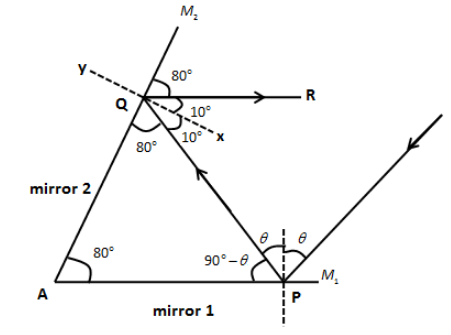Question
Question: Two plane mirrors are inclined at angle 80 degrees. A ray of light is incident on one of the mirrors...
Two plane mirrors are inclined at angle 80 degrees. A ray of light is incident on one of the mirrors. The ray after two reflections will undergo total deviation of:
A. 180 degrees
B. 160 degrees
C. 200 degrees
D. 240 degrees
Solution
We will use the concept of law of reflection which states that when light is reflected from a surface then the angle of incidence is always equal to the angle of reflection angle is measured from the path of the light to the normal to the surface to point at which light strike this is known as law of reflection. The total internal angle of the triangle is equal to 180∘.
Complete step by step answer:
Let M1and M2 be the mirror inclined at an angle θwith the plane AM.Now a ray of light PQ is incident at an angle θ on the plane mirror M. We know Snell’s law states that when a light is incident on a plane mirror at an angle θ then the light will be reflected by making an angle θ.Hence, we can say QR the reflected ray will also make an angle θ as shown in the following figure.Now let’s draw a line XY normal to the mirror AB, therefore we can say ∠PQX=∠RQX

From the above figure, since the angle ∠RQM2 is 80∘, then the angle ∠RQx=90−80=10∘. Since the angle ∠RQx=10∘, the angle ∠PQx is also 10∘. Therefore, the angle ∠AQP=90−10=80∘.
As we well know the total internal angle of a triangle is equal to 180∘. Therefore, the total angle inΔAQP is,
80∘+80∘+90∘−θ=180∘
By simplifying, we get,
θ=70∘
From the above figure, the total deviation of the light ray is,
δ=2θ+10∘+10∘
Substituting θ=70∘ in the above equation, we get,
δ=2(70∘)+10∘+10∘
∴δ=160∘
So, the correct answer is option B.
Note: Students must be careful while using the angles of incidence and the reflected as we have to always take only similar angles that are either made with the horizontal or the vertical. Always remember the angle of reflection or angle of incident are the angles made by the reflected ray or incident ray with the normal and not with the horizontal surface. Do remember the laws of reflection while answering these types of questions.
